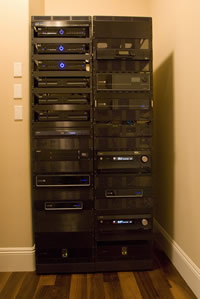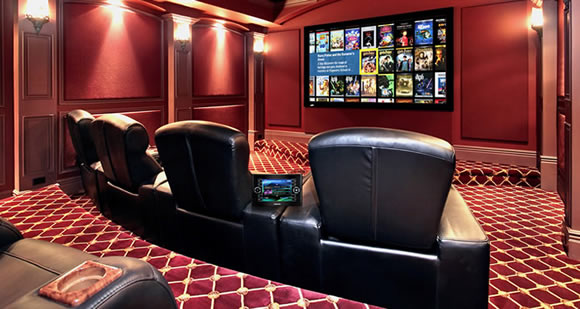Author: Robert Schlecht, HTmart.com
Once you choose your room, decide between hanging a flat-screen HDTV or a video projection screen and corresponding video projector. The most popular aspect ratio is 16:9 widescreen. A projector/screen combo will help provide that authentic movie theater experience and is the recommended solution for a dedicated home theater. If you plan on watching lots of television in addition to movies, then a HDTV may be the better option, as projector bulbs have limited lifespans and are expensive to replace.
Images provided by Audio Impact, San Diego
Holiday time is all about families, and what better place to spend family time then in your own home theater! If you received new home theater AV components over the holidays, then now is the perfect time to begin. Use your holiday vacation time to have the whole family work together on this project. Not only will owning a home theater be fun for the whole family, but it will also add resale value to your house.
Room Considerations:
First, choose what room you will use. A dark basement room with no windows is ideal, but any existing room from a spare bedroom to a rec room can be converted into a home theater. Some considerations to keep-in-mind include room location, ceiling height, ambient lighting conditions, and the overall shape of the room. For example, locating the home theater next to an infant room might not be the best location when deep booming explosions are going off during a movie. High ceilings are ideal if you are planning on putting back rows of seats on riser platforms and/or hanging a video projector from the ceiling. Block out any ambient light by removing highly reflective objects, and covering windows with blackout drapery. A long rectangular room, similar in shape to an actual movie theater, is preferred. This will allow good viewing angles from all the seating positions, and dialogue from your center-channel speaker will also have greater impact down the middle of the room.
Painting:
Ideally you want a dark room, especially on the end with the screen. Black is a safe-bet, but you can mix in other dark colors such as navy blue, dark green, burgundy, and grays. These colors come into play when considering theater seating, theater carpet and wall color. Keep your walls a dark shade to avoid reflecting light from the screen that has the undesirable effect of reducing the screen contrast. It is therefore important that the room is dark when the lights are off, so you feel like you are in a theater and there are no visual distractions. Also, make sure your screen frame is black and absorbs any light that hits it. And, you can paint your outlet covers to match your room color.
HDTV or Video Projector:

Once you choose your room, decide between hanging a flat-screen HDTV or a video projection screen and corresponding video projector. The most popular aspect ratio is 16:9 widescreen. A projector/screen combo will help provide that authentic movie theater experience and is the recommended solution for a dedicated home theater. If you plan on watching lots of television in addition to movies, then a HDTV may be the better option, as projector bulbs have limited lifespans and are expensive to replace.
AV Components:

Set up your audio components including a minimum 5.1-channel surround sound system. If Blu-ray movies are a top priority, then you may want to opt for a 7.1-channel system. You can save some money and get matched components by selecting one of the readily available Home-Theater-In-a-Box (HTiB) systems. Make sure the Total Harmonic Distortion (THD) of the AV Receiver (AVR) is very low… much less than 1% for clear sound at high volume levels. AV equipment can be hidden away in a cabinet, or placed on a rear shelf that also has the benefit of breaking up sound reflections from the front speakers. Room acoustics can be further improved by adding curtains and acoustic panels to the side walls, and carpeting the floor. Conceal your speaker cords behind baseboard or inside plastic cable concealers. Make sure to add surge protectors and/or battery-backup (UPS) systems to your sensitive electronics gear. Finally, you need to calibrate your AV system, so the picture and sound are set at their optimum levels for your environment. To calibrate, you can hire an expert or pick-up one of the many calibration DVDs for the DIY approach.
Seating:

Home theater seating is another important consideration as you will be spending lots of time sitting, especially during epic movie marathons. For seating you have lots of choices from standard sofas and recliners, to authentic cinema chairs. If you have children, don’t forget to add some kid-friendly chairs, such as Video Rockers. With most of the cinema seats, you can also select the chair width and back height. These are important factors that can maximize comfort for your home theater guests, so be sure and take body size into consideration. If you plan to have multiple rows, it’s a good idea to place the rear rows up on a higher floor riser. Once you find the perfect seats for your room, you need to make sure that you arrange them at the correct distance from the screen. Depending on the size of the screen, there is an optimal seating distance.
Lighting:
Lighting is not only functional, but decorative as well. Consider standard wall sconces for a traditional theater look, or custom wall sconces featuring your theater name to set your theater apart from the rest. Adding subtle lighting effects such as rear-lit poster cases and LED edge-lit marquees can really add to the realism of an authentic movie theater experience. Aisle lighting and step lighting will not only add a nice touch, but make the room safer upon entry and exit. You can spice up the room lighting further by adding a dimmer switch.
Decor:

Now for the fun part… the decor… it’s all about the trimmings, and this is an area where your personal taste can really shine through. Many people spend a lot of time thinking about the audio and video components, but forget the room aesthetics. If you are going to spend a lot of time in your home theater and have friends over for movie parties, then you want your media room to show off your love of movies. While decorating your home theater, you may want to consider a room theme based on your favorite movie such as Star Wars or Gone with the Wind. Or, a genre-based theme, such as Sci-Fi, Mystery, Action-Adventure, etc. You could also go with a generic movie theme, and add some film reels, movie clapboards, and wall sconces with movie themed logos and motifs.
If you are planning a specific theme, then scout out local flea markets, garage sales, and go online to find decorations, action figures, toys, props and collectibles that will complement your theme. You do-it-yourself types may even give a try at making a few custom props of your own. Framed posters of your favorite movies will also make nice decorations. If you want to give your room a unique look, then you may want to consider a personalized movie marquee or wall plaque. If you are going for that old-time, vintage look, then you may want to add an Old Fashioned MovieTime Popcorn Machine or Retro Hot Air Popper. Over the holidays, you can add some seasonal decorations for special occasions like Halloween, Thanksgiving, Christmas and New Years. Don’t forget to make your room comfortable as well. Movie-themed blankets and pillows are not only comfortable, but look great too!
Let The Fun Begin:
Now it’s time to pop-in that favorite film or holiday DVD and enjoy watching movies in your own home theater!
Click here to view the full article
http://www.hometoys.com/ezine/10.12/htmart/index.htm
